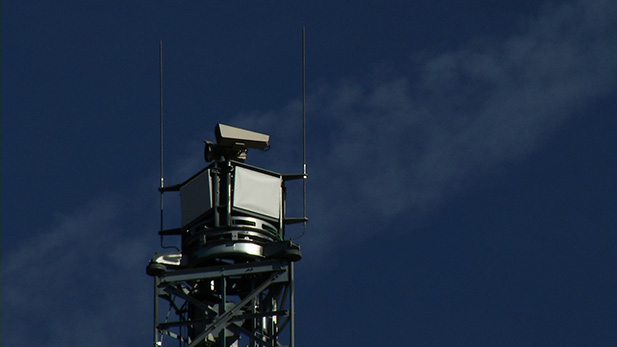Securing the border is part of every presidential candidate’s game plan for winning the election. But can the border be secured– and at what cost?
Listen:
A decade ago, a multi-billion dollar plan failed. Now federal agents use technology tested by the Department of Defense, modified for use on the U.S.- Mexico border.

In 2005 Under the Bush administration, Homeland Security launched the SBInet, the Secure Border Initiative. It was supposed to be the Holy Grail of border protection, intended to build a technology-based "virtual fence" across the U.S.-Mexico border.
What looked good on paper, say border patrol officials, was a disaster, in part, because Customs and Border Protection had little input and were forced to use technology that didn’t serve their needs.
A by-product was plummeting morale among border agents. Another problem with SBInet, say critics, is that the government failed to properly supervise the primary contractor, Boeing Company.
Six years later, under the Obama administration, then Secretary of Homeland Security Janet Napolitano cancelled the program.
"SBInet is a contract and a concept that was entered into years ago, has been plagued with troubles from day one," Napolitano told a Congressional committee in 2011.
"It has never met a deadline, it has not met it’s operational capacities and it doesn’t give us what we need to have.”
Turns out what border officials needed, all along, they all ready had. It is tried and true technology currently in use by the U.S. Department of Defense. It relies on off the shelf equipment that doesn’t need to be engineered from the ground up like the failed SBInet system.
“So we scaled down our ambitions somewhat and selected a much more modest portfolio of systems that the Border Patrol selected and tailored to each area of the Border," Mark Borkowski, the head of Customs and Border Protection told an October 2015 congressional hearing. "We focused it on Arizona because that’s where the action was at the time. We are in the throes of completing that plan which we call the Arizona Technology Plan.”

The main component of the Arizona Technology Plan is a tower. While there have been cameras mounted on towers along the border for decades, these towers are called Integrated Fixed Towers because of the radar component and high-tech day-and-night cameras that can be controlled by an operator sitting miles away in a control room.
“What the radar does, it sweeps 24/7 this whole valley that we’re looking at. As you can see the terrain is very remote, it’s in the middle of nowhere," Border Patrol Agent Vicente Paco said. "Anything out here, the radar is going to pick it up. Something that is here – that wasn’t there before– it is going to send a signal out to the operator sitting in the camera room south in Nogales.
Just how good are these super cameras and the radar technology?,
“The cameras are so good that they, we, can zoom into the vehicle license plate and get a license plate number,” Paco said.
Eventually, there will be 52 of these Integrated Fixed Towers along the Arizona-Mexico Border in the Tucson sector.
Right now there are seven. The price tag for the first phase is around $145 million dollars and the contract was awarded to an Israeli-based defense company.
Customs and Border Protection officials say this technology – while scaled down – works. Illegal border crossings are down and morale among agents is up.
“We often get attracted by the bright shiny thing," Borkowski told the congressional hearing. "We can’t impose technologies on people who use it. We have to involve them and they have to invite us to bring technologies. We need to remember not to do in the future.”

By submitting your comments, you hereby give AZPM the right to post your comments and potentially use them in any other form of media operated by this institution.